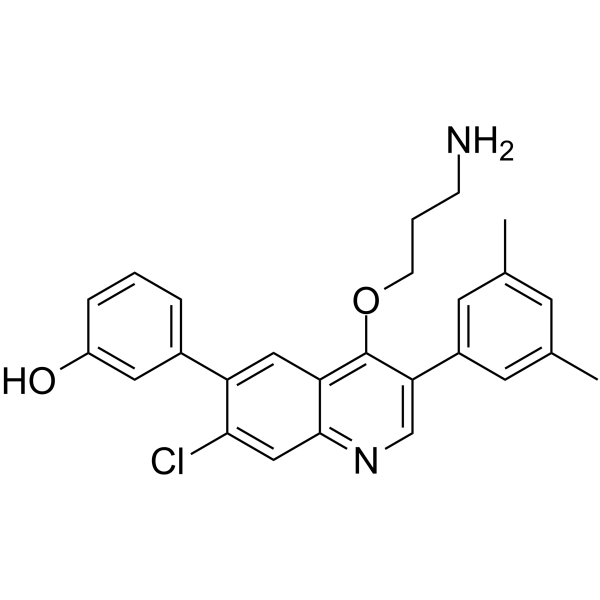| Description |
sst2 Receptor agonist-1 is a potent somatostatin receptor subtype 2 (sst2) agonist with a Ki value of 0.025 nM and a cAMP IC50 value of 4.8 nM. sst2 Receptor agonist-1 can inhibit rat growth hormone (GH) secretion and ocular neovascular lesion formation. Antiangiogenic effect[1].
|
| Related Catalog |
|
| Target |
sst2:0.025 nM (Ki)
sst2:4.8 nM (IC50)
|
| In Vivo |
sst2 Receptor agonist-1 (compound 21) (0.2 or 2 mg/kg; IV; single dosage) shows a dose-dependent decrease in growth hormone (GH) secretion[1]. sst2 Receptor agonist-1 (5 or 15 μg/per eye; intraocular; once every 4 days) reduces neovascular lesion area in laser choroidal neovascularization (CNV) rat model[1]. Pharmacokinetic Parameters of sst2 Receptor agonist-1 (compound 21) in dogs and rats[1]. species dog (IV 0.125 mg/kg) rat (IV 2 mg/kg or 5 mg/kg) CLplasma (mL/min/kg) 7.1 52 t1/2 (h) 11 2.9 VdSS (L/kg) 5.7 9.4 F (%) ND 17 Animal Model: Female Wistar rats (200-250 g; IP injection with 50 mg/kg pentobarbital, then injected with tested compound via jugular cannula, after 40 or 50 min administration, injected with GH secretagogue via jugular cannula)[1] Dosage: 0.2 or 2 mg/kg Administration: IV; single dosage Result: Caused a dose-dependent decrease in GH secretion (38 and 91% reduction in plasma GH AUC following administration of 0.2 and 2 mg/kg, respectively). Animal Model: Male Brown Norway rats (175-225 g; lasered and perfused, a 27G needle was used to make a small hole in the eye 3 mm posterior to iris angled 45° toward the optic nerve)[1] Dosage: 5 or 15 μg/per eye, 5 μL Administration: Intraocular administration; inject at day 0, 4 and 8 Result: Exhibited a dose-dependent antiangiogenic effect by a 35 and 53% reduction in neovascular lesion area with 5 or 15 μg per eye, respectively.
|
| References |
[1]. Wolkenberg SE, et al. Design, synthesis, and evaluation of novel 3,6-diaryl-4-aminoalkoxyquinolines as selective agonists of somatostatin receptor subtype 2. J Med Chem. 2011 Apr 14;54(7):2351-8.
|
